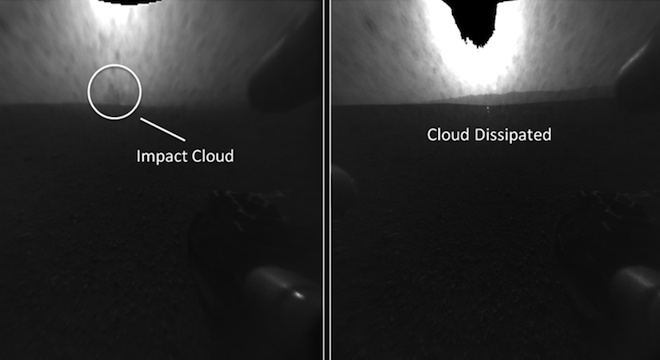On the fourth full day after the Mars Curiosity Rover landed on the surface of the Red Planet, NASA scientists finally have a clearer picture of just how the rover’s descent went, where it is located, and when it will begin its mission to explore the Martian geology for signs that the planet ever could’ve supported life.
“We missed the entry target by only about one mile,” said Adam Steltzner, lead engineer of the NASA Mars Curiosity Rover’s entry, descent, and landing phase, or EDL, in a press conference at NASA’s Jet Propulsion Laboratory in Pasadena, California on Friday.
The near-perfect landing was messy in another, quite literal sense though. NASA scientists on Friday announced in a press conference that the rover’s rear-facing hazard camera had snapped a picture of a giant dust cloud being kicked up on the Martian surface by the nearby (planned) crash of the rover’s descent stage, a separate component of the landing craft with rockets that fired to stabilize and guide the rover toward the ground and a sky crane that deployed to lower it all the way down.
Here’s a NASA animated GIF image of the cloud going up and then vanishing about 45 minutes later, representing what Curiosity saw after it landed:

And here’s the before and after shots, with the cloud up on the left then gone in the image at the right:

“Landing on Mars is a very, very dirty event,” said Steve Sell, another NASA scientist in charge of the rover’s powered flight operation. “We’re basically off-roading for the next two years. If you take your SUV and actually use it to off-road you expect it to get a bit dirty.”
Indeed, other photos taken by the rover of itself show it covered with pebbles thrown up by the landing, which NASA doesn’t expect to hinder its operations whatsoever. Here’s one composite:

After the descent stage was done, it broke apart from the rover as planned and smashed into ground a few miles away, as seen in the following image snapped by the Mars Reconnaissance Orbiter, a NASA satellite orbiting the red planet. The rover is on the edge of the line to the right and the descent stage is to the very left. The crash of the landing stage is what is thought to have produced the dust cloud.

On the Martian surface, the rover itself ended up being 1.5 miles away from its intended precise target — but still within its landing ellipse, a 12-mile-by-4-mile wide expanse on the edge of Gale Crater, a massive 90-mile-wide depression where NASA scientists think liquid water may have existed in an earlier time on Mars. That makes it the most accurate rover landing NASA, or anyone, has ever performed on another planetary body.
Specifically, the rover is located in an area known as “Yellowknife,” or quadrant 51, located on the eastern central part of Mars, close to the planet’s equator.
As Mars Curiosity trajectory specialist Jody Davis noted in NASA’s press conference, which was also live-streamed on its website, that the precise location of the rover at present has already been marked on Google Mars, the online mapping equivalent of Google Earth. Users have to download extra 3D software to see it, however.
NASA scientists said that as of Friday afternoon, they would begin updating the rover’s onboard operating system from one designed to handle the landing operation and initial equipment check-out and image-snapping to a new, more advanced version designed to power the rover’s 10 scientific instruments and give it the ability to drive to the nearby Mount Sharp, a 3.4-mile-tall feature in Gale Crater where NASA will use the rover to study Martian geology through the ages. The process is similar to how a user would update the operating system on his or her home PC, smartphone or tablet. It is expected to take four days, between August 10 and August 13.






